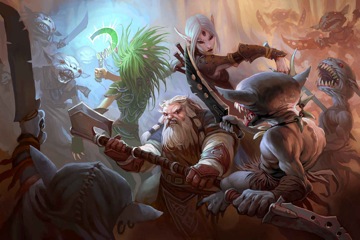Pathfinder Advanced Player's Guide Preview #1Thursday, July 1, 2010
The start of Gen Con 2010 is five weeks away, which means that the Advanced Player's Guide will be hitting game stores and subscriber mailboxes in just over one month. To celebrate the release of this impressive tome, we are going to be previewing parts of it every week until its release. Last week we recapped the information from the PaizoCon APG Preview Banquet. This week we are going to dig into some details with an extensive look at the races chapter.
As I mentioned last week, each of the seven core races receives a two-page spread of information. Each spread starts out with information about adventurers of that race, taking on each of the 17 classes available (that includes the six new classes found in the APG). This is followed up by alternate racial traits that allow characters to portray members of the race that are a little different than the rest, but still well within the theme of the race. To take one of these alternate racial traits, a character has to give up one or more existing racial traits. For example, take a look at this dwarven racial trait.
Stonesinger: Some dwarves' affinity with the earth grants them greater powers. Dwarves with this racial trait are treated as one level higher when casting spells with the earth descriptor or using granted powers of the Earth domain, the bloodline powers of the earth elemental bloodline, and revelations of the oracle's stone mystery. This racial trait replaces the stonecunning racial trait.
Or how about this Half-Orc racial trait.
Toothy: Some half-orcs' vestigial tusks are massive and sharp, granting them a bite attack. This is a primary natural attack that deals 1d4 points of piercing damage. This racial trait replaces the orc ferocity racial trait.
Each replacement racial trait is made to explore one facet of the race's inherent theme. Elves get abilities that tie them to nature, gnomes get abilities that explore their fascinations, half-elves can take abilities that help them live in both worlds, halflings can focus on their sneaky talents, and even humans are not left out. Humans can take racial traits that reflect their upbringing.
In addition to a host of racial traits, each race also receives a number of favored class options. These options are tied to a race's theme in most cases, meaning that races only receive options for classes that are racially common. Possessing one of these options just gives your character an additional choice whenever he gains a level in his favored class (instead of a skill point or a hit point). For example, take a look at this elven wizard favored class option.
Wizard: Select one arcane school power at 1st level that is normally usable a number of times per day equal to 3 + the wizard's Intelligence modifier. The wizard adds +1/2 to the number of uses per day of that arcane school power.
Once an elven wizard takes this power twice, he gains an additional use of that ability. Want more, take a look at this gnome bard favored class option.
Bard: Add 1 to the gnome's total number of bardic performance rounds per day.
Of all the races, only humans have an option for all 17 classes. Here is the human sorcerer favored class option.
Sorcerer: Add one spell known from the sorcerer spell list. This spell must be at least one level below the highest spell level the sorcerer can cast.
Although this chapter is only 18 pages long, in a 336-page book, it is absolutely crammed full of new rules for characters of any race and class, a philosophy we took with the entire rest of the book. Next week, we will delve into the classes chapter, starting off by taking a look at the six new base classes in the book, and I might even go into some detail on the changes made to them after the playtest was over.
Jason Bulmahn
Lead Designer
We have updated our Privacy Policy.
Paizo.com uses cookies. You can block paizo.com from using cookies within your browser settings, but doing so will hinder site functionality.
More information can be found in our Privacy Policy.
